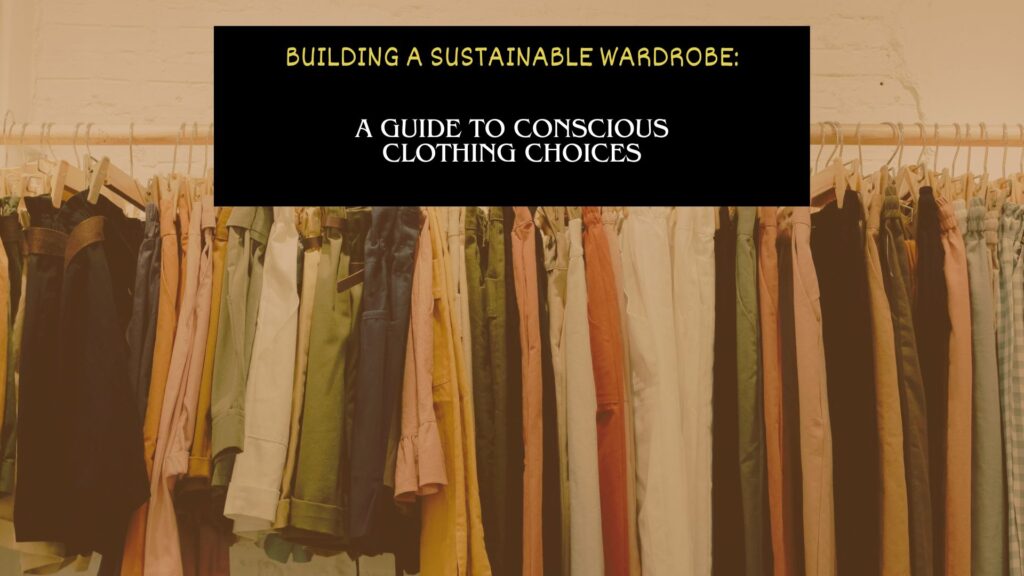Everything You Should Know About Sustainable Fashion, Its History, And Current Trends

History of Sustainable Fashion:
A Stitch in Time: The Evolution of Sustainable Clothing
In an era where environmental consciousness is gaining momentum, sustainable clothing, also known as eco-friendly clothing, has emerged as a beacon of responsible fashion. This movement towards eco-friendly garments is not just a passing trend but a significant shift in the fashion industry’s mindset, reflecting a growing awareness of the environmental impact of clothing production. Let’s take a journey through the history of sustainable clothing, tracing its roots and the strides made to promote ethical and eco-conscious fashion.
Early Beginnings:
The concept of sustainable clothing can be traced back to the mid-20th century when concerns about environmental pollution and labor exploitation started to gain prominence. The Slow Fashion movement, a response to the fast fashion industry’s negative consequences, began advocating for durable, timeless pieces and ethical production practices.
1980s and 1990s:
During the 1980s and 1990s, awareness about environmental issues grew, leading to the rise of sustainable fashion pioneers. Brands such as Patagonia and Eileen Fisher emerged, prioritizing sustainable materials, fair labor practices, and transparency in their supply chains. These early trailblazers set the stage for the sustainable fashion movement to gain momentum in the coming decades.
2000s and 2010s:
The 21st century witnessed a significant surge in interest and demand for sustainable clothing. Eco-friendly materials like organic cotton, hemp, and recycled polyester gained popularity. Numerous fashion brands, both established and emerging, began integrating sustainable practices into their operations. The use of eco-friendly dyes, recycled packaging, and ethical labor practices became central to the industry’s narrative.
The Rise of Circular Fashion:
In recent years, the concept of circular fashion has gained traction. This approach emphasizes the entire lifecycle of clothing, focusing on designing durable and recyclable products. Brands are now exploring innovative ways to repurpose materials, reduce waste, and encourage consumers to participate in clothing recycling programs.
Technology and Innovation:
Advancements in technology have played a crucial role in the sustainable clothing revolution. From the development of new eco-friendly fabrics to the use of artificial intelligence in optimizing supply chain efficiency, technology has become a driving force behind environmentally conscious fashion practices.
The Future of Sustainable Clothing:
As we look ahead, the future of sustainable clothing appears promising. The fashion industry is witnessing a paradigm shift, with consumers increasingly prioritizing ethical and eco-friendly choices. Governments and organizations are also implementing regulations and standards to encourage sustainability in the fashion supply chain.
The history of sustainable clothing is marked by a gradual awakening to the environmental and social impacts of the fashion industry. From humble beginnings, the movement has evolved into a global effort to create a more sustainable and ethical future for fashion. As consumers continue to demand transparency and eco-conscious choices, the fashion industry is compelled to adapt, ensuring that sustainability becomes an integral part of the fabric of our clothing choices.
The Dirty Secrets of Fast Fashion: Unveiling Environmental and Social Costs
In recent decades, the fashion industry has undergone a seismic shift with the rise of fast fashion. While this trend has made trendy clothing more accessible and affordable, there are hidden environmental and social costs that remain largely unnoticed. This article aims to shed light on the dark underbelly of fast fashion, exposing its contribution to climate change, pollution, and unfair labor practices.
Environmental Impact:
Fast fashion is synonymous with rapid production cycles and disposable clothing, leading to an astonishing environmental toll. The industry is a major contributor to greenhouse gas emissions, as the production, transportation, and disposal of clothing all release significant amounts of carbon dioxide into the atmosphere. Moreover, the overuse of natural resources such as water and land, combined with the widespread application of harmful chemicals in textile production, has severe consequences for ecosystems and biodiversity.
Pollution:
One of the dirty secrets of fast fashion lies in its polluting footprint. From toxic dyes to synthetic materials, the manufacturing processes of fast fashion items often involve the release of hazardous chemicals into water sources. These pollutants not only harm aquatic life but also find their way into the food chain, posing risks to human health. Additionally, the disposal of cheap, low-quality garments contributes to the growing problem of textile waste, with landfills overflowing with non-biodegradable fabrics.
Unfair Labor Practices:
Behind the glitzy storefronts and online platforms showcasing the latest fashion trends, a shadowy reality persists for many workers in the fashion industry. Cheap labor, poor working conditions, and exploitation are rampant in the supply chains of fast fashion giants. Workers, especially in developing countries, are often subjected to long hours, low wages, and unsafe working environments. The race to produce clothing at the lowest cost leads to a cycle of exploitation that perpetuates poverty and human rights abuses.
Social Inequities:
The impact of fast fashion extends beyond the factory floor, affecting entire communities. As large corporations seek to maximize profits, they often contribute to social inequities by exploiting vulnerable populations. From land displacement to the disruption of traditional artisanal practices, the unchecked growth of fast fashion exacerbates social disparities and threatens cultural heritage.
While fast fashion has become an integral part of the modern consumer landscape, it is crucial to acknowledge and address the hidden environmental and social costs associated with this industry. As consumers, we hold the power to drive change by making informed choices, supporting sustainable and ethical brands, and advocating for transparency within the fashion supply chain. By raising awareness about the dirty secrets of fast fashion, we can work towards a more sustainable and socially responsible future for the fashion industry.
Building a Sustainable Wardrobe: A Guide to Conscious Clothing Choices
In a world increasingly focused on environmental consciousness, the fashion industry has been under scrutiny for its environmental impact. Fast fashion, characterized by mass production and rapid turnover of trendy items, contributes significantly to pollution and resource depletion. However, individuals can make a positive difference by adopting sustainable practices in their wardrobes. This article will guide you on how to build a sustainable wardrobe by making mindful choices in your clothing selection and care.
1. Embrace Secondhand Shopping
One of the most effective ways to reduce the environmental impact of your wardrobe is by embracing secondhand shopping. Thrift stores, consignment shops, and online platforms dedicated to pre-loved items offer a treasure trove of unique and affordable fashion finds. By choosing secondhand, you contribute to the circular economy, extending the lifespan of clothing and diverting items from landfills.
2. Prioritize Natural Fibers
When shopping for new clothing, prioritize garments made from natural fibers such as organic cotton, linen, hemp, and Tencel. Unlike synthetic fabrics like polyester, natural fibers decompose more easily, reducing the environmental burden. Additionally, organic farming practices eliminate the use of harmful pesticides and chemicals, promoting a healthier planet.
3. Invest in Timeless Pieces
Build a wardrobe filled with timeless pieces that withstand the test of trends. By opting for classic styles and neutral colors, you can create versatile outfits that remain fashionable over time. This approach reduces the need for constant wardrobe updates, curbing the demand for fast fashion and minimizing your environmental footprint.
4. Learn the Art of Clothing Maintenance
Extend the life of your clothing by learning basic mending and repair skills. Sewing on a missing button, patching up a small hole, or hemming a pair of pants can make a significant impact on the longevity of your garments. Numerous online tutorials and workshops make it easy for anyone to acquire these essential skills, empowering individuals to take charge of their clothing’s lifecycle.
5. Participate in Clothing Swaps
Organize or participate in clothing swaps with friends, family, or your local community. Swapping clothes is an excellent way to refresh your wardrobe without contributing to the demand for new items. It’s a sustainable and social activity that fosters a sense of community while reducing textile waste.
Building a sustainable wardrobe is not just a fashion statement; it’s a commitment to environmental responsibility. By adopting practices such as secondhand shopping, choosing natural fibers, investing in timeless pieces, and learning how to maintain and repair your clothes, you contribute to a more sustainable and ethical fashion industry. Small choices collectively make a significant impact, and your conscious decisions can inspire positive change in the way we approach clothing consumption.
Sustainable Fashion on a Budget: Stylish and Eco-Friendly Choices That Won’t Break the Bank
In recent years, the fashion industry has witnessed a growing demand for sustainable and eco-friendly clothing. Many individuals are becoming increasingly conscious of the environmental impact of fast fashion and are seeking alternatives that align with their values. However, a common misconception persists that sustainable fashion comes with a hefty price tag. This article aims to debunk that myth by highlighting the affordability of sustainable clothing and offering practical tips for those looking to embrace eco-friendly fashion on a budget.
1. Second-Hand Treasure Hunt: Embracing sustainable fashion doesn’t always mean buying brand new items. Thrift stores, consignment shops, and online platforms for second-hand clothing are excellent places to discover unique and affordable pieces. Not only does buying second-hand reduce waste, but it also gives clothing a second life, contributing to a circular fashion economy.
2. Clothing Swaps: Organizing or participating in clothing swaps with friends or within your community is a fun and cost-effective way to refresh your wardrobe sustainably. This allows you to exchange clothing items you no longer need for something new-to-you, without spending a dime.
3. Renting Fashion: If you have a special event or occasion, consider renting an outfit instead of buying something new. Numerous online platforms offer clothing rental services, allowing you to wear high-quality, stylish pieces without the commitment of ownership. This reduces the demand for new clothing production and helps minimize your fashion footprint.
4. Capsule Wardrobe Approach: Building a capsule wardrobe involves selecting a few versatile, timeless pieces that can be mixed and matched for various outfits. By focusing on quality over quantity, you can invest in durable, sustainable items that will last longer, ultimately saving you money in the long run.
5. Research Affordable Sustainable Brands: While some sustainable fashion brands may have higher price points, many others offer affordable options without compromising on eco-friendly practices. Conduct research and discover brands that prioritize ethical sourcing, fair labor practices, and environmentally conscious production methods while remaining budget-friendly.
6. DIY and Upcycling: Unleash your creativity by upcycling old clothing items or giving them a new lease on life through do-it-yourself projects. Adding patches, embroidery, or repurposing garments can transform your wardrobe without the need for new purchases.
Sustainable fashion on a budget is not only achievable but also an empowering and rewarding journey. By adopting a mindful approach to your clothing choices, exploring second-hand options, participating in clothing swaps, renting, and researching affordable sustainable brands, you can curate a stylish and eco-conscious wardrobe without breaking the bank. Making small changes in your fashion choices contributes to a more sustainable and responsible industry, proving that you don’t need a hefty budget to dress in harmony with the planet.
Embracing the Future: The Evolution of Sustainable Fashion
In a world increasingly conscious of its environmental footprint, the fashion industry is undergoing a transformative shift towards sustainability. The traditional linear model of ‘take, make, and dispose’ is being replaced by a circular economy that prioritizes eco-friendly practices. This article explores the latest trends and technologies in sustainable fashion, shedding light on the promising future of an industry at the forefront of positive change.
Material Innovation: Sustainable fashion is witnessing a surge in material innovation. Designers are exploring alternative fabrics derived from organic sources such as bamboo, hemp, and Tencel, which have a lower environmental impact compared to conventional materials like cotton. Additionally, advancements in lab-grown textiles and recycled fibers are paving the way for a more sustainable and cruelty-free future.
Circular Design Principles: The shift towards circular fashion is gaining momentum. Designers are adopting principles like durability, repairability, and recyclability, ensuring that garments have a longer lifespan. Brands are also embracing take-back programs and recycling initiatives to close the loop and reduce fashion’s contribution to landfills.
Technology and Transparency: Technology is playing a pivotal role in driving sustainability in fashion. Blockchain, for instance, is being used to enhance transparency in the supply chain, allowing consumers to trace the journey of their garments from raw materials to the finished product. Augmented reality (AR) is being employed for virtual try-ons, reducing the need for physical stores and the associated carbon footprint.
3D Printing and Customization: The emergence of 3D printing is revolutionizing the way fashion items are produced. This technology allows for precise and efficient manufacturing, minimizing waste. Customization is also gaining traction, as consumers seek personalized, timeless pieces, reducing the reliance on fast fashion and its inherently wasteful practices.
Resale and Second-hand Market: The rise of the resale market is reshaping consumer behavior. Second-hand and vintage shopping are becoming not only economically savvy but also environmentally conscious choices. Online platforms dedicated to pre-loved fashion are thriving, contributing to a more sustainable and circular fashion ecosystem.
Consumer Education and Ethical Choices: As consumers become more aware of the environmental and ethical implications of their purchases, they are demanding greater transparency from brands. Sustainable fashion is not merely a trend but a lifestyle choice. Consumers are increasingly making informed decisions, favoring brands that align with their values and contribute to positive social and environmental impacts.
The future of sustainable fashion is promising, marked by a harmonious blend of innovation, technology, and conscious consumer choices. As the industry continues to evolve, it is crucial for both consumers and fashion stakeholders to collaborate in fostering a more sustainable, circular, and ethical fashion landscape. By embracing these positive changes, the fashion industry has the potential to not only reduce its environmental impact but also set new standards for responsible and forward-thinking business practices.
Embrace Eco-Fashion: DIY Sustainable Clothing Projects for a Greener Wardrobe
In an era where environmental consciousness is gaining momentum, sustainable fashion has become more than just a trend—it’s a lifestyle. Making the switch to eco-friendly clothing doesn’t always require a complete wardrobe overhaul; instead, you can embark on a creative journey with DIY sustainable clothing projects. Upcycling old clothes or crafting your own sustainable pieces not only reduces textile waste but also adds a unique touch to your wardrobe.
T-Shirt Transformation:
Start with a classic DIY project by transforming old t-shirts into trendy and sustainable pieces. Cut out the neckline to create an off-the-shoulder look, or turn it into a crop top. You can also experiment with tie-dye techniques using natural dyes made from fruits and vegetables. This project not only breathes new life into old garments but also provides a creative outlet for self-expression.
Denim Revival:
Give your old jeans a fresh lease on life by turning them into stylish and sustainable fashion statements. Transform denim into a trendy pair of shorts, add fabric patches for a boho-chic vibe, or create a unique denim tote bag. The possibilities are endless, and you’ll be amazed at how a few alterations can breathe new life into old denim pieces.
Patchwork Perfection:
Combine fabric scraps and worn-out clothes to create a patchwork masterpiece. Whether you’re revamping a pair of jeans, a jacket, or even a tote bag, patchwork adds a touch of individuality and sustainability to your wardrobe. This project not only reduces textile waste but also allows you to showcase your creativity through vibrant patterns and colors.
DIY Tie-Dye Magic:
Tie-dyeing is a timeless technique that can transform plain garments into eye-catching works of art. Instead of using synthetic dyes, opt for natural alternatives such as beet juice, turmeric, or avocado pits to create stunning, eco-friendly patterns. Whether you’re customizing a t-shirt, hoodie, or even a pair of socks, tie-dyeing adds a playful and sustainable twist to your wardrobe.
Sew Your Own Sustainable Garments:
For those with basic sewing skills, consider creating your own sustainable garments from scratch. Choose organic and ethically sourced fabrics to make a positive impact on both the environment and the people involved in the production process. Sewing your own clothes allows you to control every aspect of the design, ensuring a perfect fit and a clear conscience.
Embarking on DIY sustainable clothing projects not only contributes to reducing the environmental impact of fast fashion but also allows you to unleash your creativity. By upcycling old clothes or crafting your own sustainable pieces, you not only refresh your wardrobe but also make a meaningful contribution to a greener and more eco-conscious future. Embrace the journey of sustainable fashion, one DIY project at a time.
The Impact of Sustainable Clothing on Climate Change
Climate change is one of the most pressing issues of our time, and as individuals, we have a responsibility to contribute to solutions that mitigate its effects. One often overlooked aspect of our daily lives that significantly influences the environment is the clothing industry. The production, distribution, and disposal of clothing contribute to carbon emissions and environmental degradation. However, the growing movement towards sustainable clothing offers a promising avenue for individuals to make a positive impact on climate change.
The Carbon Footprint of Conventional Clothing:
Traditional fashion practices rely heavily on resource-intensive processes, including the cultivation of raw materials, manufacturing, and transportation. The production of synthetic fabrics, such as polyester, involves the use of fossil fuels and releases greenhouse gases into the atmosphere. Additionally, the fast fashion model, characterized by rapid production and disposal of clothing, leads to a massive amount of waste in landfills.
The Rise of Sustainable Fashion:
Sustainable clothing represents a shift towards environmentally friendly practices in the fashion industry. This approach encompasses various aspects, including the use of eco-friendly materials, ethical labor practices, and conscious consumption. Many sustainable clothing brands prioritize organic fabrics, recycled materials, and innovative manufacturing techniques that minimize environmental impact.
Reducing Carbon Emissions:
One of the key ways sustainable clothing contributes to combating climate change is by reducing carbon emissions. Organic cotton, for example, requires less energy and water to grow compared to conventional cotton. Moreover, sustainable brands often employ eco-friendly dyeing processes and energy-efficient manufacturing methods, further decreasing their carbon footprint.
Circular Economy and Waste Reduction:
Sustainable fashion promotes a circular economy, encouraging the reuse, recycling, and upcycling of clothing. By extending the lifespan of garments, individuals can significantly reduce the demand for new clothing production. This, in turn, minimizes the carbon emissions associated with manufacturing and transportation. Thrift shopping, clothing swaps, and donation programs play crucial roles in promoting a more sustainable approach to fashion consumption.
Consumer Awareness and Ethical Choices:
The impact of sustainable clothing on climate change is also driven by consumer choices. As awareness grows about the environmental and social consequences of fast fashion, individuals are increasingly making ethical choices in their clothing purchases. Supporting sustainable brands and adopting a minimalist approach to fashion can lead to a more sustainable and eco-conscious wardrobe.
The fashion industry’s role in climate change is undeniable, but the growing popularity of sustainable clothing offers hope for positive change. By opting for eco-friendly materials, embracing circular economy practices, and making conscious choices, individuals can contribute to reducing their carbon footprint. As consumers, we have the power to drive demand for sustainable fashion and, in doing so, play a vital role in mitigating the impact of clothing production on our planet.
Sustainable Clothing for a Healthy Planet: A Win-Win for You and Mother Earth
In an era where environmental concerns are at the forefront of global discussions, sustainable practices have become a crucial aspect of daily life. One area that has gained significant attention is the fashion industry, where the shift towards sustainable clothing is not just a trend but a necessity for a healthier planet. This article explores the benefits of sustainable clothing, emphasizing its positive impact on both our well-being and the environment.
Environmental Impact:
Traditional clothing production often involves harmful practices such as excessive water consumption, chemical usage, and carbon emissions. In contrast, sustainable clothing prioritizes eco-friendly materials like organic cotton, hemp, and recycled fibers. These materials reduce the carbon footprint, conserve water, and minimize the use of toxic substances, contributing to a cleaner and greener planet.
Health Benefits:
The impact of sustainable clothing goes beyond the environment; it directly influences our health. Conventional textiles may contain harmful chemicals, pesticides, and synthetic dyes that can cause skin irritations and allergies. Sustainable fabrics, on the other hand, are typically free from these toxins, making them gentler on the skin and promoting overall well-being. Choosing organic and natural fibers ensures that your clothing is not only fashionable but also safe for your body.
Ethical Manufacturing Practices:
Sustainable clothing often comes from brands that prioritize ethical manufacturing practices. This includes fair wages, safe working conditions, and the avoidance of exploitative labor. By supporting such brands, consumers contribute to the creation of a fair and just global fashion industry that values the well-being of workers and fosters a positive social impact.
Extended Lifespan:
Fast fashion promotes a culture of disposable clothing, contributing to an alarming amount of textile waste. Sustainable fashion encourages quality over quantity, focusing on durability and timeless designs. Investing in well-made, timeless pieces not only reduces the need for constant replacements but also minimizes the environmental impact associated with the disposal of clothing.
Cost-Effective in the Long Run:
While sustainable clothing may seem more expensive upfront, it proves to be cost-effective in the long run. High-quality materials and craftsmanship ensure that these garments last longer, requiring fewer replacements. Additionally, the environmental and health benefits associated with sustainable clothing make it a wise investment for both individuals and the planet.
As consumers become more conscious of their choices, the demand for sustainable clothing continues to grow. Choosing eco-friendly, ethical, and health-conscious options not only positively impacts the environment but also contributes to a healthier and more sustainable future. By embracing sustainable fashion, we can all play a part in creating a world where style and responsibility go hand in hand.
SUGGESSTED: PRIVATE LABEL SUSTAINABLE CLOTHING
Exploring the Best Sustainable Fabric Choices for a Greener Future
In a world increasingly focused on environmental consciousness, the fashion industry is undergoing a significant shift towards sustainability. One crucial aspect of this transformation is the choice of fabrics. As consumers become more aware of the environmental impact of their clothing, the demand for sustainable fabrics has surged. Let’s delve into some of the best sustainable fabric options that are not only eco-friendly but also contribute to a more responsible and ethical fashion industry.
Organic Cotton:
Organic cotton is a frontrunner in sustainable fashion. Unlike conventional cotton, which relies heavily on pesticides and synthetic fertilizers, organic cotton is grown using natural methods. This fabric is not only gentler on the environment but also promotes healthier farming practices, reducing the risk of harmful chemicals leaching into the soil and water.
Tencel (Lyocell):
Tencel, derived from wood pulp, is an eco-friendly fabric that has gained popularity for its sustainability and versatility. The production process involves a closed-loop system, where the solvent used to break down the wood pulp is recycled, minimizing waste. Tencel fabrics are known for their breathability, softness, and wrinkle resistance, making them a favorite for both casual and formal wear.
Hemp:
Hemp is a robust and versatile plant that requires minimal water and pesticides to grow. The fibers extracted from hemp are durable, breathable, and naturally resistant to mold and UV rays. Clothing made from hemp is not only environmentally friendly but also long-lasting, contributing to a reduction in overall textile waste.
Recycled Polyester:
Traditional polyester is infamous for its environmental impact due to its reliance on non-renewable resources and energy-intensive production. However, recycled polyester, made from post-consumer plastic bottles and other recycled materials, offers a more sustainable alternative. By repurposing existing materials, this fabric helps reduce the demand for new raw materials and minimizes plastic waste in landfills and oceans.
Bamboo:
Bamboo fabric has gained popularity for its rapid growth, low water requirements, and minimal need for pesticides. The fabric is naturally antibacterial and moisture-wicking, making it an excellent choice for activewear and undergarments. However, it’s essential to consider the processing methods, as some bamboo fabrics may involve chemicals that impact their overall sustainability.
As the fashion industry continues to evolve, the importance of sustainable fabrics cannot be overstated. The choices we make as consumers and producers can significantly impact the environment. By opting for fabrics like organic cotton, Tencel, hemp, recycled polyester, and bamboo, we contribute to a more sustainable and ethical fashion landscape. As we embrace these eco-friendly alternatives, we not only reduce our ecological footprint but also support a shift towards a more responsible and environmentally conscious industry.
SUGGESTED: DOWNLOAD SUSTAINABLE FLANNEL CATALOG
Embracing Eco-Friendly Comfort: The Best Sustainable Flannel Clothing
In the ever-evolving world of fashion, sustainability has become a central focus for both consumers and manufacturers. As individuals become more environmentally conscious, the demand for eco-friendly clothing has surged. Flannel, a timeless and versatile fabric, has also undergone a sustainable makeover. Today, we explore the world of sustainable flannel clothing and discover the best options for those who prioritize both style and environmental responsibility.
The Rise of Sustainable Fashion:
The fashion industry has long faced scrutiny for its environmental impact, including excessive water usage, pollution, and unethical labor practices. In response to these concerns, sustainable fashion has gained momentum, emphasizing responsible sourcing, ethical production, and eco-friendly materials. Flannel, a fabric commonly associated with warmth and comfort, is no exception to this shift towards sustainability.
Key Characteristics of Sustainable Flannel Clothing:
1. Organic and Recycled Materials:
The best sustainable flannel clothing often starts with the use of organic cotton or recycled fibers. Organic cotton eliminates the use of harmful pesticides and promotes soil health, while recycled fibers reduce the demand for virgin resources, minimizing the environmental footprint.
2. Responsible Production Processes:
Manufacturers committed to sustainability prioritize responsible production practices. This includes ethical labor conditions, fair wages, and reduced energy consumption during the manufacturing process. By choosing flannel clothing from brands with transparent supply chains, consumers can support companies dedicated to positive social and environmental impact.
3. Durable and Timeless Designs:
Sustainable flannel clothing goes beyond just eco-friendly materials; it also focuses on creating durable and timeless designs. This approach encourages consumers to invest in quality pieces that withstand the test of time, reducing the need for frequent replacements and minimizing waste.
Sustainable Clothing Suggestions for 2024
The year is 2024, and the winds of change are sweeping through the fashion industry. Consumers are becoming increasingly aware of the environmental impact of their clothes, and the demand for sustainable options is skyrocketing. But navigating the world of eco-conscious fashion can be tricky. Fear not, style-savvy comrades! Here are some tips to build a wardrobe that’s kind to the planet and flatters your figure:
1. Embrace the Power of “Pre-loved”: Secondhand clothing isn’t just thrifted finds anymore. Resale platforms like ThredUp and Poshmark offer a treasure trove of designer deals and vintage gems. Give pre-loved pieces a new lease on life, and reduce your carbon footprint significantly. Check out local consignment shops and swap meets for unique finds with a story.
2. Invest in Quality Basics: Ditch the “fast fashion” frenzy and opt for well-made staples that will last for seasons. Look for natural fibers like organic cotton, linen, and hemp, which are more durable and kinder to the environment. Classic cuts like a crisp white shirt or a versatile blazer can be endlessly reimagined through styling, eliminating the need for constant updates.
3. Material Matters: Dive deeper into the fabrics you choose. Tencel, bamboo lyocell, and recycled polyester are just a few sustainable alternatives to conventional materials. Check for certifications like GOTS (Global Organic Textile Standard) or Oeko-Tex to ensure responsible production practices.
4. Repair, Reuse, Repurpose: Before tossing a worn-out garment, see if it can be salvaged. A skilled tailor can fix a torn seam or replace a button. Get creative with DIY alterations – turn jeans into shorts, add lace to a plain dress, or use scraps to create new accessories. Every stitch saved is a victory for the planet.
5. Support Sustainable Brands: Do your research and choose brands that are committed to ethical production and eco-friendly practices. Look for companies that use recycled materials, offer repair services, and prioritize fair labor conditions. Patagonia, Eileen Fisher, and Stella McCartney are just a few of the pioneers leading the sustainable fashion charge.
6. Make it Minimalist: Resist the urge for impulse buys and cultivate a “less is more” approach. A curated wardrobe with fewer, high-quality pieces allows you to mix and match, creating endless outfit combinations without overflowing your closet. Remember, style isn’t defined by quantity, but by individuality and conscious choices.
7. Get Vocal: The power of consumer demand is undeniable. By voicing your preference for sustainable options, you send a message to the fashion industry. Ask retailers about their sustainability practices, and advocate for stricter regulations in the industry.
Remember, embracing sustainable clothing isn’t just about trends – it’s about building a mindful relationship with fashion. By making conscious choices, you can create a wardrobe that reflects your values, flatters your form, and treads lightly on the planet. So step into your stylish stride, and show the world that looking good and doing good can go hand in hand in 2024 and beyond!















